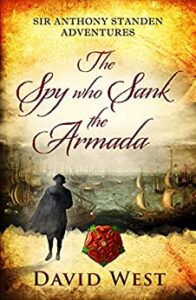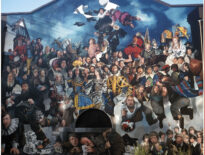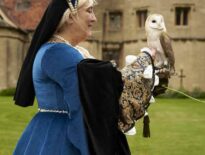 Thank you to David West for writing this guest article for us. David is the author of The Sir Anthony Standen Adventures series of novels, book one of which, The Spy who Sank the Armada is his fictional biography of Sir Anthony, his 10th great-granduncle.
Thank you to David West for writing this guest article for us. David is the author of The Sir Anthony Standen Adventures series of novels, book one of which, The Spy who Sank the Armada is his fictional biography of Sir Anthony, his 10th great-granduncle.
Over to David...
I first encountered Sir Anthony Standen while reading George Malcolm Thompson’s biography of Sir Francis Drake. “The time had come when Walsingham was no longer satisfied with news that came to him at second-hand, whether from Santa Cruz’s kitchen or from the Governor of Guernsey’s reports of the gossip on Breton ships or in Rouen taverns. He needed an accurate and detailed stream of information about the number of Philip’s ships, their tonnage, the sailors who would man them and the soldiers they would carry. Thanks above all to Standen, he got what he wanted.” Because my mother’s maiden name was Standen, I was immediately intrigued. Who was this man? Why hadn’t I heard of him before? Might he be an ancestor of mine?
My first stop was the Oxford Dictionary of National Biography, where Paul Hammer had written an excellent piece on him. He was the eldest son of Edmund Standen, who lived in East Molsey, adjacent to Hampton Court Palace. Anthony accompanied Henry Stuart, Lord Darnley, to Scotland when Darnley went to marry Mary Queen of Scots. Queen Elizabeth disapproved and the journey took place without her permission. By Anthony’s account, he saved the life of Mary when Darnley and his uncle assassinated her secretary, David Riccio. Standen was knighted for this, either by Mary or by Darnley, depending on the source. In the chaos that followed Riccio’s murder, Standen went to Paris and sought employment from the English Ambassador, Sir Henry Norris. Norris was replaced by Francis Walsingham, and around this time Standen gained a pension from the Spanish and based himself in Flanders.
Standen was forced to flee Flanders when he was discovered to be having an inappropriate relationship with Barbara Von Blomberg, a former mistress of Emperor Charles V, and mother of Don Juan, Duke of Austria, and now Spanish governor of the Netherlands. Standen travelled as far as Constantinople before settling in Florence working for the Duke of Tuscany. He remained in regular correspondence with Walsingham. When the Duke and Duchess died, Standen had to leave. He then began sending Walsingham detailed intelligence of the Spanish Armada. In 1590 Standen’s Spanish masters sent him to Bordeaux. Here he was arrested as a spy and imprisoned. Eventually Anthony Bacon arranged his release. He returned to Spain to spy for Bacon’s uncle, Baron Burghley. After his return with Bacon to England, he was knighted by Queen Elizabeth, and began working for Robert Devereux, Earl of Essex. He accompanied him on raids to Cadiz and the Azores, then on Essex’s fateful expedition to Ireland. Standen didn’t return to England until he heard of Elizabeth’s death and the accession of King James. Claiming favour as the saviour of Jame’s mother when Riccio was murdered, he secured a commission taking the news of Jame’s succession to European courts. When he returned to London, Robert Cecil had letters implicating him in a Papal plot to encourage Anne of Denmark, Jame’s queen, to seek a more tolerant policy towards Catholics. He was sent to the Tower of London, and the report of the Venetian ambassador to London, which I have read in the British Library, is quite clear that he will never leave alive. Yet he was released and breached the condition of his passport by travelling to Rome.
The date and place of his death are unknown.
 I read as many of the sources that Hammer cited as possible. The letters in the archive of the Duke of Tuscany are online via JSTOR. Daphne Du Maurier uses much detail from these letters in her book, The Golden Lads, in which Sir Anthony is a minor character. Having read the ODNB entry I felt this was the most extraordinary story I had read, but kept asking myself two questions: why did he do that? And how did he do that? I had been between Open University courses when I read the Sir Francis Drake biography, Creative Writing, and Advanced Creative Writing. So I decided the only way I was going to find out, was to write the story myself, weaving my imagined why and how into the known fabric of Sir Anthony’s life. It was after completing The Spy who Sank the Armada that I discovered, through Ancestry, that Anthony’s younger brother Edmund was my 10th great-grandfather. I have caught the bug for writing historical fiction. Details of all my books, book reviews, news and blog are on my website https://www.davidvswest.co.uk
I read as many of the sources that Hammer cited as possible. The letters in the archive of the Duke of Tuscany are online via JSTOR. Daphne Du Maurier uses much detail from these letters in her book, The Golden Lads, in which Sir Anthony is a minor character. Having read the ODNB entry I felt this was the most extraordinary story I had read, but kept asking myself two questions: why did he do that? And how did he do that? I had been between Open University courses when I read the Sir Francis Drake biography, Creative Writing, and Advanced Creative Writing. So I decided the only way I was going to find out, was to write the story myself, weaving my imagined why and how into the known fabric of Sir Anthony’s life. It was after completing The Spy who Sank the Armada that I discovered, through Ancestry, that Anthony’s younger brother Edmund was my 10th great-grandfather. I have caught the bug for writing historical fiction. Details of all my books, book reviews, news and blog are on my website https://www.davidvswest.co.uk



My maiden name was standen and I am fascinated by this person – is he real? Do oh have any specific information on him ie date of birth etc i would like to add them to my family tree
Apologies Maria, I haven’t visited The Tudor Society for a while and have just seen your comment. He’s real. I don’t have a date of birth for him. His father Edmund my 11th great-grandfather was born in 1528 in Kingston Upon Thames and died in 1571 in East Molsey. My 10th great-grandfather also Edmund, was born in 1567 and died in 1639. His son Thomas, my 9th great-grandfather was born on 13th July 1594 in Etchingham. I hope that helps.